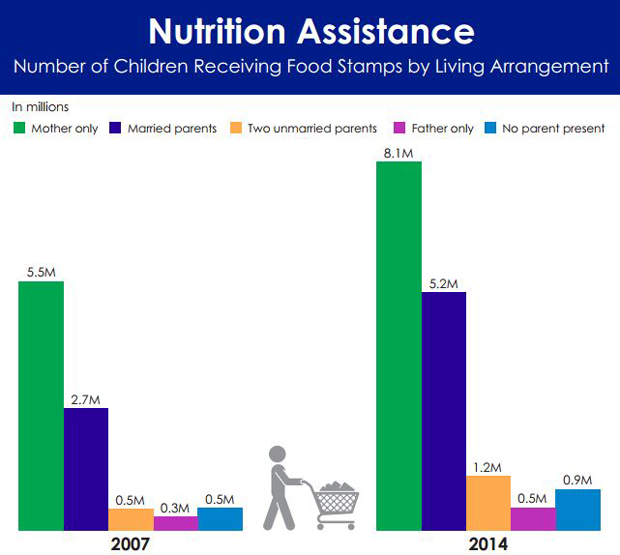1 in 5 American kids rely on food stamps
America is a global leader on a number of fronts, including having the largest economy in the world. But here is one area where the U.S., given its general affluence, would rather not distinguish itself: It has one of the highest rates of child poverty in the industrialized world.
Even as the economy continues to recover from the Great Recession, 1 in 5 children are on food stamps, the U.S. Census said on Wednesday. Before the housing crash, 1 in 8 received federal food assistance.
This dismal statistic reflects how the recovery is failing to reach families at the lower end of the economic spectrum. While the stock market has reached record highs and the richest 1 percent are on a path to own most of the world's wealth by 2016, many American families continue to struggle to put food on the table. The U.S. now has the second-highest rate of child poverty among 35 industrialized nations, according to the Children's Defense Fund, a child advocacy group.
That is a "shameful distinction," the group said in a new report. "Many countries with fewer resources have lower poverty rates, including the U.K., New Zealand, the Czech Republic and Hungary, a clear indication the U.S. could do much more to reduce child poverty."
The only industrialized country with a higher poverty rate? Romania, a country that is still struggling to emerge from brutal decades under Communism and is only now starting to create a middle class.
About 15 million U.S. children live below the official poverty level of about $24,000 for a family of four, the Children's Defense Fund found. Children in the U.S. have a 20 percent chance of being poor, while children of color are twice as likely to be poor as white kids.
"It's shocking, and it doesn't have to be this way," Caroline Fichtenberg, director of research at the Children's Defense Fund, told CBS MoneyWatch. "It's in our economic interest to address child poverty."
There's a cost to America's high rate of child poverty, the Children's Defense Fund said. Because financially strapped parents have fewer resources and less time -- many work multiple jobs to make ends meet -- they are less likely to spend time talking and reading to their children. Hunger and food insecurity also lead to health problems, as well as a higher chance of obesity, and poor students are less likely to graduate from high school, which depresses their earnings potential.
"The lost productivity and extra health and crime costs stemming from child poverty add up to roughly half a trillion dollars a year, or 3.8 percent of GDP," the report noted.
Food stamps are just one of the costs. Last year, the food-assistance program provided benefits for 16 million children, compared with 9 million before the recession started in December of 2007. The rate of children who live with married parents and who are receiving food stamps, meanwhile, has doubled in that same time period, the Census said.
The findings come amid increased concern from economists and policy makers about the growing gap in the U.S. between the rich and everyone else. The top 1 percent of income earners captured all the income gains since the recession officially ended in June 2009 in 16 states, while capturing at least half of all gains in another 22 states, according to the Economic Policy Institute, a left-leaning think tank.
While the "War on Poverty," started by President Lyndon Johnson in the 1960s to lower America's poverty rate, has been successful, the recession hit many lower- and middle-income families hard.
"Why we have the feeling we're treading water is the economy has changed," Fichtenberg said. "We have fewer jobs that pay enough to get by, we have wage stagnation and all the benefits have gone to the top 1 percent. Coming out of the recession, children have been the first to suffer and the last to benefit."
Boosting the fortunes of the middle class was the main theme of President Obama's State of the Union address last week. His proposals include raising the capital gains tax and eliminating a loophole that benefits wealthy families, with the additional tax monies used to fund educational benefits and tax cuts for middle-income earners.
Reducing poverty among America's children could be achieved through policy measures such as increasing the Earned Income Tax Credit for lower-income families and boosting the minimum wage, the Children's Defense Fund said. Those and other policy measures could reduce the country's child poverty rate by 60 percent, the group said.
"By investing more in protecting children from poverty the U.S. could rejoin the ranks of peer nations," the report noted. "Shrinking the U.S. relative child poverty rate by 60 percent would cut child poverty in the U.S. from 23.1 to 9.2 percent, placing the U.S. in line with countries like Germany and Switzerland."
Many of the government's social safety net benefits help families as they cope with periods of income loss or financial stress, and don't necessarily lead to dependence on government handouts, Fichtenberg added.
"We have a culture that focuses on individual responsibility, and we completely agree with that, but we are all in the same boat and it's in everybody's interest" to lift children out of poverty, she said. "Children don't choose their parents or who they are born to."
